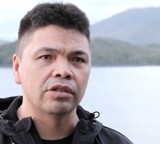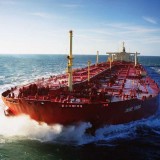Enbridge’s proposal to build a 1,172 km Northern Gateway pipeline from Alberta to Kitimat through some of the most challenging and remote territory on the planet exposes wild rivers, landscapes and a pristine BC coast to inevitable oil spills. This is the most obvious argument against building this project. But a closer and deeper scrutiny reveals more fundamental flaws that are not immediately obvious.
While Enbridge may assume responsibility for the safety of its pipeline – offered with the usual over-confidence of a developer promoting its project – it cannot claim responsibility for the fleet of international tankers that would arrive almost daily to transport the oil to foreign ports. Such tanker traffic is risky enough in open waterways and accessible harbours. But a trip to Kitimat to back to sea again would require huge and notoriously unmanoeuvrable ships to navigate 580 km of narrow, winding channels. Reefs, storms, tide rips, fog, extreme waves and complex course changes make the passage treacherous. And who guarantees the quality of the ships and seamanship that would ply BC waters? Foreign captains and crews on vessels registered in countries of convenience introduce risks for oils spills that are beyond the control of Enbridge.
Enbridge’s focus, of course, is the pipeline, a $5.5 billion investment that would provide considerable employment when being built but little thereafter – except to the burgeoning oil industry processing bitumen from Alberta’s tar sands. And, as critics rightly point out, the pipeline would be a viable investment only if it operates at capacity. The pipeline, therefore, is a means to both justify and encourage the development of the tar sands, a source of oil that is recognized as “dirty” because of pollution and the huge quantities of energy and water used in production. These larger implications compound the need for a careful examination of the whole project.
So, why the hurry and why the federal government’s objections to a thorough environmental assessment of the Northern Gateway project? Because other oil supplies will soon be available when new technologies are extracting oil from the vast shale sources being discovered elsewhere. The hurry is to secure markets before the opportunity evaporates, a race that inevitably leads to miscalculations, undue risk and promised trouble. And future competition could make this pipeline less than profitable, subjecting it to the eventual cost-cutting measures that are prelude to disaster.
The rush to build the Northern Gateway also obscures long-term perspectives. Canada has no national energy policy. The $20 billion invested in the tar sands by China may be in China’s interests, but what of Canada’s? The eastern half of this country gets its oil from foreign sources arriving in Atlantic ports, a compromise to national energy security. Why not develop the tar sands to meet Canadian interests, refine our own oil on site, and thereby gain energy self-reliance and extra jobs?
This raises the issue of “ethical oil”, an argument used by advocates for the Keystone XL pipeline that is proposed to transport Alberta crude to America’s Gulf States. Foreign oil, they argue, is deemed “unethical” because it comes from countries of dubious political reputation. The same argument is being applied to the Northern Gateway pipeline. Although Alberta’s oil is environmentally “dirty” and the transportation route is risky, at least Asia, like the US, would be receiving Canada’s “ethical oil”. Curiously, the argument doesn’t seem to apply to the half of Canada presently receiving its oil from the same international sources as other countries. Why is the issue of “ethical oil” applicable to the US and Asia but not to Canada? Wouldn’t we be more “ethical” by supplying ourselves with our own “ethically” superior oil?
Money, of course, lurks behind the facade of “ethics”. Huge amounts are to be made by building the Northern Gateway pipeline. Most of the benefits, however, would go to Alberta and the oil industry operating there. Canada would benefit from thousands of new jobs. But as usual, the issue is more complicated than first appearances. Robyn Allen, a noted Canadian economist, points out in her study of the Northern Gateway project that the premium price received for oil going to Asia would force up the price in Canada by $2-3 per barrel, an effect that would dampen the Canadian economy and counteract any benefits accruing from the pipeline. The multi national investors in Alberta’s oil industry would benefit at the expense of everyone else in Canada.
And this raises the phenomenon of the so-called “Dutch Disease”. The Dutch discovered to their chagrin that a huge influx of revenue from oil inflated the value of their currency, made their exports more expensive and less competitive, increased unemployment and weakened their entire economy.
Other disadvantages of oil-supported economies are also noteworthy. Unstable boom-and-bust economic cycles are created by fluxuating oil prices. And a single source of monetary wealth tends to cause governments to neglect the other vital drivers in their economies.The resulting loss of diversity is diminished democracy, alienation, cynicism and social unrest. The eventual outcome is the failed petro-state so reviled for its “unethical” characteristics.
And a final argument against the Northern Gateway pipeline is the extra carbon dioxide emissions it will encourage. Refining Alberta’s tar sands already produces about 6 percent of Canada’s total greenhouse gases. A doubling of production will double emissions to about 12 percent – an annual 90 million tonnes of CO2 equivalent by 2020. This output further handicaps Canada’s ability to meet its reduction obligations to the global community and further vilifies Canada’s already dismal environmental reputation. From every conceivable perspective, the Northern Gateway is a pipeline to problems.
Postscript: In order “…to find the best solution for Canada”, Enbridge is considering changing its pipeline port from Kitimat to Prince Rupert (Globe & Mail, Feb. 10/12).





